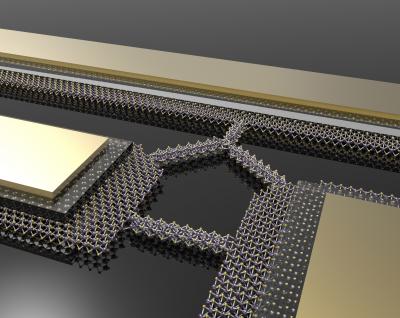Junhao Lin, a Vanderbilt University Ph.D. student and visiting scientist at Oak Ridge National Laboratory (ORNL), has found a way to use a finely focused beam of electrons to create some of the smallest wires ever made. The flexible metallic wires are only three atoms wide: One thousandth the width of the microscopic wires used to connect the transistors in today’s integrated circuits.
Lin’s achievement is described in an article published online on April 28 by the journal Nature Nanotechnology. According to his advisor Sokrates Pantelides, University Distinguished Professor of Physics and Engineering at Vanderbilt University, and his collaborators at ORNL, the technique represents an exciting new way to manipulate matter at the nanoscale and should give a boost to efforts to create electronic circuits out of atomic monolayers, the thinnest possible form factor for solid objects.
“Junhao took this project and really ran with it,” said Pantelides.
Lin made the tiny wires from a special family of semiconducting materials that naturally form monolayers. These materials, called transition-metal dichalcogenides (TMDCs), are made by combining the metals molybdenum or tungsten with either sulfur or selenium. The best-known member of the family is molybdenum disulfide, a common mineral that is used as a solid lubricant.
Atomic monolayers are the object of considerable scientific interest these days because they tend to have a number of remarkable qualities, such as exceptional strength and flexibility, transparency and high electron mobility. This interest was sparked in 2004 by the discovery of an easy way to create graphene, an atomic-scale honeycomb lattice of carbon atoms that has exhibited a number of record-breaking properties, including strength, electricity and heat conduction. Despite graphene’s superlative properties, experts have had trouble converting them into useful devices, a process materials scientists call functionalization. So researchers have turned to other monolayer materials like the TMDCs.
Other research groups have already created functioning transistors and flash memory gates out of TMDC materials. So the discovery of how to make wires provides the means for interconnecting these basic elements. Next to the transistors, wiring is one of the most important parts of an integrated circuit. Although today’s integrated circuits (chips) are the size of a thumbnail, they contain more than 20 miles of copper wiring.
“This will likely stimulate a huge research interest in monolayer circuit design,” Lin said. “Because this technique uses electron irradiation, it can in principle be applicable to any kind of electron-based instrument, such as electron-beam lithography.”
One of the intriguing properties of monolayer circuitry is its toughness and flexibility. It is too early to predict what kinds of applications it will produce, but “If you let your imagination go, you can envision tablets and television displays that are as thin as a sheet of paper that you can roll up and stuff in your pocket or purse,” Pantelides commented.
In addition, Lin envisions that the new technique could make it possible to create three-dimensional circuits by stacking monolayers “like Lego blocks” and using electron beams to fabricate the wires that connect the stacked layers.
The nanowire fabrication was carried out at ORNL in the microscopy group that was headed until recently by Stephen J. Pennycook, as part of an ongoing Vanderbilt-ORNL collaboration that combines microscopy and theory to study complex materials systems. Junhao is a graduate student who pursues both theory and electron microscopy in his doctoral research. His primary microscopy mentor has been ORNL Wigner Fellow Wu Zhou.
“Junhao used a scanning transmission electron microscope (STEM) that is capable of focusing a beam of electrons down to a width of half an angstrom (about half the size of an atom) and aims this beam with exquisite precision,” Zhou said.



This new technique of synthesizing nanowires developed by Junhao provides us with a revolutionary new to alter and change matter on a molecular scale. Especially in the application of electronics on a nanoscale, but more specifically it is these new wire’s ability to conduct an electric current, especially through a conductor with such a thin diameter. This means Junhao has overcome the obstacle of internal resistance which increases as the width of the conductor (in this case nanowires) decreases. This may be a simple problem he has overcome but it is a fundamental element in electronics and is not easily solved. Furthermore this technology is not just limited to nanowires but can be applied to any kind of electron-based instrument. This truly is a extraordinary accomplishment.
Why do they specifically use materials such as the combination of the metal molybdenum with sulfur, but not materials like gold to make the nanowires?
Today’s world seems to be obsessed with the idea of touchscreen devices (I am currently using my iPad to type this, for example), and this is due to the multipurpose nature of such devices. Monolayer nanotechnology is the subject of many research programmes, especially involving graphene. The uses of these monolayers seem to go on and on – for example, a screen made of plastic and only 1% of graphene is highly conductive, which may act as a replacement for Gorilla Glass, which is made using many rare and irreplaceable materials. Essentially, nanotechnology can make the technology we use not only cheaper, but more environmentally friendly.
I am a first year student at the University of Pretoria. I find this post really interesting. I have only recently been introduced to nanotechnology, and is amazed by the “endless” possibilities that it have. It is almost unimaginable to think that such a small wire have been created. I am inspired that a student studying his doctoral have find this new technology, it let you believe in your self and maybe one day I will also be part of such a discovery myself. I will keep an eye out to see where this technology is used.